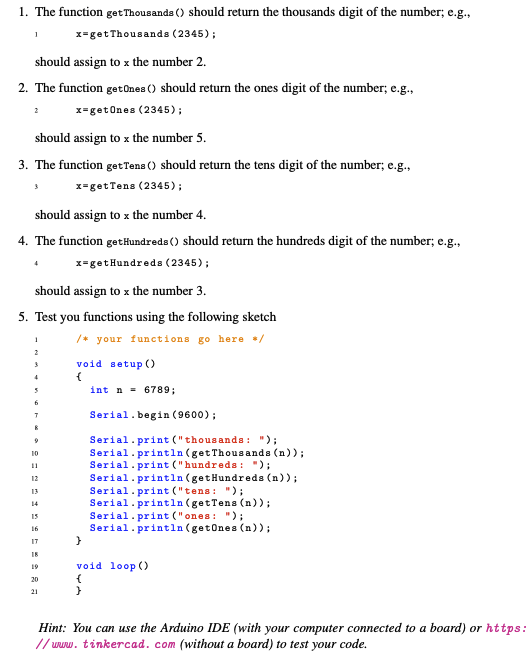1. The function get Thousands () should return the thousands digit of the number; e.g., 1=get Thousands (2345); should assign to x the number 2. 2. The function getünes () should return the ones digit of the number, e.g., 1-getOnes (2345); should assign to x the number 5. 3. The function getTens () should return the tens digit of the number; e.g., 1=getTens (2345); should assign to x the number 4. 4. The function getHundreds () should return the hundreds digit of the number; e.g., x=getHundreds (2345); should assign to x the number 3.
1. The function get Thousands () should return the thousands digit of the number; e.g., 1=get Thousands (2345); should assign to x the number 2. 2. The function getünes () should return the ones digit of the number, e.g., 1-getOnes (2345); should assign to x the number 5. 3. The function getTens () should return the tens digit of the number; e.g., 1=getTens (2345); should assign to x the number 4. 4. The function getHundreds () should return the hundreds digit of the number; e.g., x=getHundreds (2345); should assign to x the number 3.
C++ Programming: From Problem Analysis to Program Design
8th Edition
ISBN:9781337102087
Author:D. S. Malik
Publisher:D. S. Malik
Chapter6: User-defined Functions
Section: Chapter Questions
Problem 1TF: Mark the following statements as true or false:
a. To use a predefined function in a program, you...
Related questions
Question
Write 3 functions, all of them taking as input an integer between 0 and 9999, with the following functionalities:

Transcribed Image Text:1. The function get Thousanda () should return the thousands digit of the number; e.g.,
x=get Thousands (2345);
should assign to x the number 2.
2. The function get0nes () should return the ones digit of the number; e.g.,
x=getOnes (2345);
2
should assign to x the number 5.
3. The function getTena () should return the tens digit of the number; e.g.
x=getTens (2345);
should assign to x the number 4.
4. The function getHundreds () should return the hundreds digit of the number; e.g.,
x=getHundreds (2345);
should assign to x the number 3.
5. Test you functions using the following sketch
/* your functions go here /
void setup ()
4
int n = 6789;
Serial.begin (9600);
Serial.print ("thousands: ");
Serial.println (getThousands (n));
Serial.print ("hundreds: ");
Serial.println (getHundreds (n));
Serial.print ("tena: ");
Serial.println (getTens (n));
Serial.print ("ones: ");
Serial.println (getOnes (n));
10
11
12
13
14
15
16
17
18
void loop ()
19
20
21
Hint: You can use the Arduino IDE (with your computer connected to a board) or https:
// uww. tinkercad. com (without a board) to test your code.
Expert Solution
This question has been solved!
Explore an expertly crafted, step-by-step solution for a thorough understanding of key concepts.
This is a popular solution!
Trending now
This is a popular solution!
Step by step
Solved in 2 steps with 1 images

Knowledge Booster
Learn more about
Need a deep-dive on the concept behind this application? Look no further. Learn more about this topic, computer-science and related others by exploring similar questions and additional content below.Recommended textbooks for you

C++ Programming: From Problem Analysis to Program…
Computer Science
ISBN:
9781337102087
Author:
D. S. Malik
Publisher:
Cengage Learning

C++ Programming: From Problem Analysis to Program…
Computer Science
ISBN:
9781337102087
Author:
D. S. Malik
Publisher:
Cengage Learning